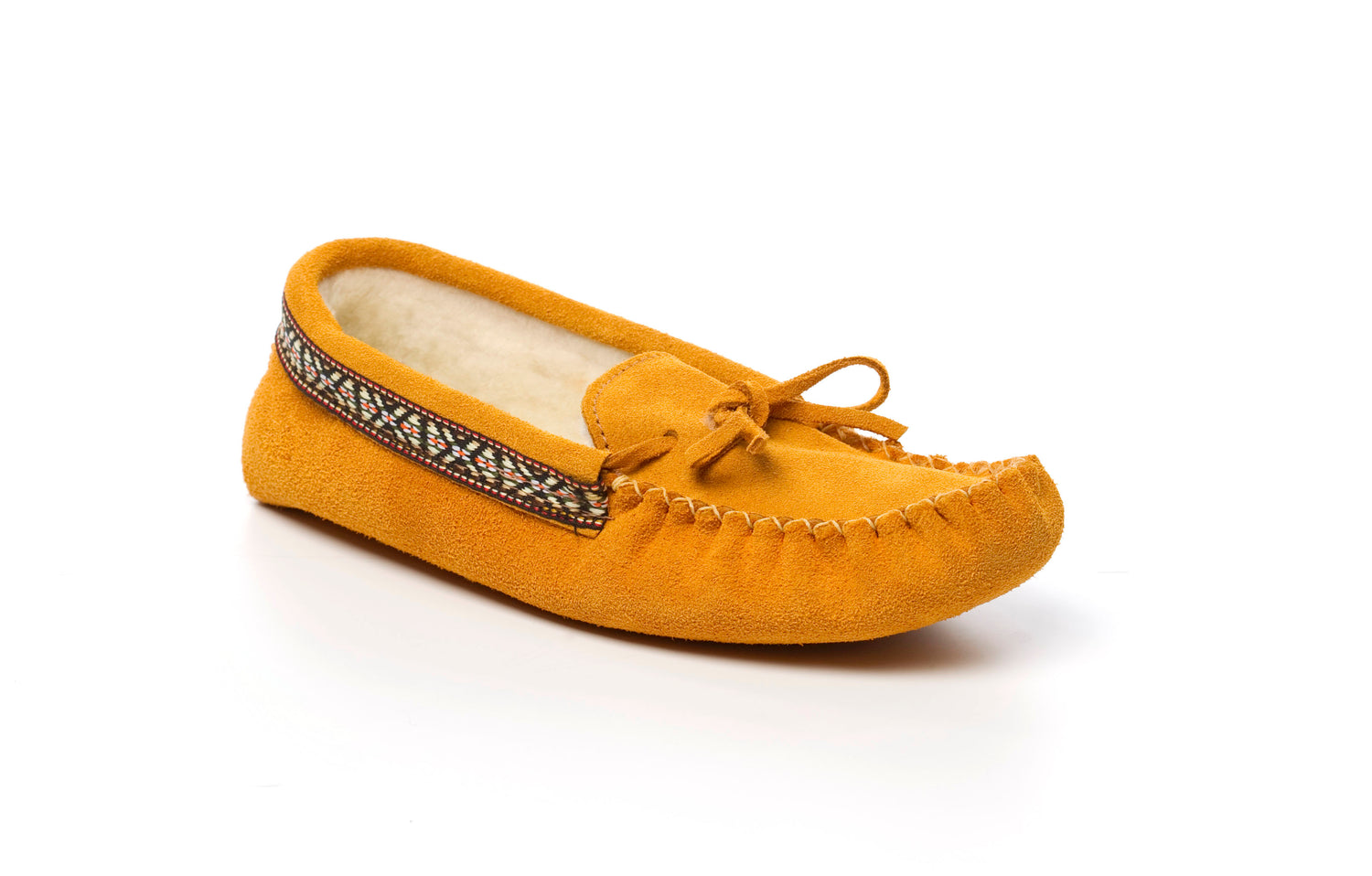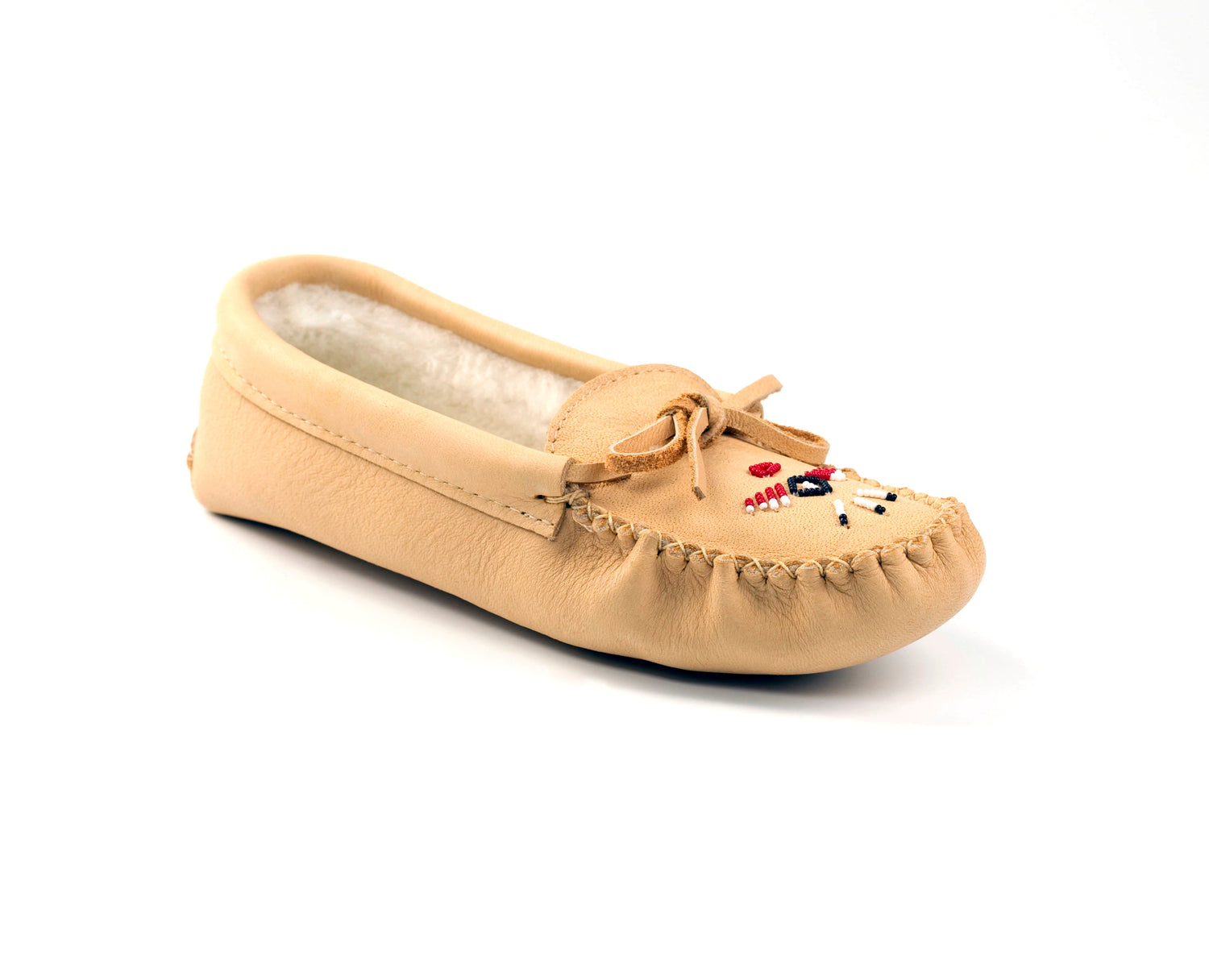
The Soul of the Sole: Leather Types in Moccasins and Mukluks
Share
The Soul of the Sole: Leather Types in Moccasins and Mukluks
The Foundation - A Legacy of Natural Materials
At the heart of every authentic moccasin and mukluk lies the leather from which it is crafted. Far more than just a material, leather lends these traditional footwear types their distinct character, durability, and unparalleled comfort. The choice of leather is paramount, influencing everything from the flexibility and warmth to the aesthetic appeal and longevity of the finished product. From time-honoured Indigenous techniques to modern sustainable practices, the journey of hide to footwear is a testament to natural processes and skilled craftsmanship.
In Canada, the acquisition of high-quality hides, particularly moosehide and deerskin, is deeply rooted in respectful and often Indigenous-led hunting practices. Moose, a majestic and abundant animal in the Canadian wilderness, provides a hide that is renowned for its exceptional strength, durability, and natural thickness. Deerskin, while generally thinner and more supple than moosehide, offers a luxurious softness and flexibility that is highly prized for certain styles of moccasins and slippers. These animals are typically harvested for food, and the hides are then carefully preserved as a valuable byproduct, ensuring that no part of the animal goes to waste. This approach aligns with the principles of sustainable living and resourcefulness that have long defined Indigenous cultures.
Beyond moose and deer, other leathers such as cowhide and various suedes also play a significant role. Cowhide, being readily available and highly versatile, can be processed to create a range of textures, from sturdy full-grain to velvety suede. Suede, characterized by its napped, fuzzy surface, can be derived from various animals and is celebrated for its softness and plush feel. The selection of these materials is not arbitrary; each type of leather contributes unique properties that make it ideally suited for different components and styles of moccasins and mukluks, ensuring the wearer experiences both comfort and authenticity.
The Art of Tanning - From Raw Hide to Supple Leather
The transformation of raw animal hide into usable leather is an ancient and intricate process known as tanning. This crucial step prevents decomposition, adds flexibility, and enhances the hide's natural properties. While modern industrial tanning often involves chrome tanning for speed and efficiency, many Canadian producers, especially those focused on traditional moccasins and mukluks, still favor or complement with more natural, vegetable-based tanning methods.
Vegetable tanning, using natural tannins found in bark, leaves, and other plant matter, is a time-honoured process that can take weeks or even months. This method yields a leather that is highly durable, develops a rich patina over time, and often carries a distinct, earthy aroma. It's a more environmentally friendly approach, reducing the use of harsh chemicals. The hides are carefully cleaned, de-haired, and then immersed in a series of tanning liquors, allowing the tannins to gradually penetrate and chemically alter the protein structure of the hide. This meticulous process is what gives vegetable-tanned leather its renowned strength and character.
Quality control is an ongoing process throughout tanning. Skilled technicians visually inspect each hide for consistency in thickness, evenness of color, and flexibility. They look for any signs of damage from the tanning process itself, ensuring that only the best sections proceed to the next stages. The natural process of transforming a raw hide into a supple piece of leather is an art form, requiring patience, expertise, and a deep understanding of the material's inherent qualities. This careful attention ensures that the final leather is robust enough to withstand the rigours of footwear manufacturing while maintaining the natural beauty and comfort that customers expect.
Understanding Imperfections - The Beauty of Natural Scars and Abrasions
One of the most distinguishing characteristics of genuine, high-quality leather, particularly from wild animals like Canadian deer and moose, is the presence of natural scars and abrasions. Far from being defects, these marks tell the story of the animal's life and are a true indicator of authenticity. Unlike synthetic materials or heavily processed, "corrected grain" leathers, natural hides retain these unique features, making each moccasin or mukluk truly one-of-a-kind.
Moosehide, known for its robust and thick texture, often displays more prominent markings. A moose’s life in the wilderness involves navigating dense forests, encountering other animals, and enduring varied weather conditions. Scars from minor injuries, rubs against trees, insect bites, or even historical brands can all be visible on the finished leather. These marks contribute to the rugged, authentic appeal of moosehide moccasins and mukluks, highlighting the natural origin of the material.
Similarly, deerskin—while softer and more delicate—can also bear the subtle traces of the deer's life. Small nicks, scratches, or variations in grain speak to the natural environment from which the hide came. These "imperfections" are celebrated by artisans and discerning consumers alike, as they confirm that the leather is genuine and has not been excessively processed to achieve an artificial, uniform look.
The presence of these natural scars and abrasions is a hallmark of quality and authenticity. It demonstrates that the leather has been minimally altered, preserving its natural strength and unique character. When selecting hides for moccasin and mukluk manufacturing, skilled cutters will strategically place patterns to either highlight or subtly integrate these features, ensuring they enhance the overall aesthetic rather than detract from it. Embracing these natural marks is a part of appreciating the inherent beauty and history of the leather.
Page 4: From Hide to Footwear - Crafting Moccasins and Mukluks
Once the leather has been expertly tanned and carefully inspected, it is ready for the skilled hands of the artisans who will transform it into moccasins and mukluks. This final stage combines traditional craftsmanship with precise manufacturing techniques, ensuring both durability and the signature comfort these footwear types are known for.
For moccasins, pieces of leather are carefully cut from patterns designed to maximize the hide and incorporate its unique features. The distinctive "moc-toe" construction, often hand-laced, is a defining characteristic, providing flexibility and a roomy fit. Soles are then attached, which can range from soft, flexible leather for indoor slippers to durable rubber or multiple layers of padded leather for outdoor wear. Linings, often made from plush sheepskin or soft fleece, are added for warmth and luxurious comfort. The final touch of hand-beading, embroidery, or other decorative elements further enhances the unique identity of each pair, echoing the ancestral artistry that defined the original moccasins.
Mukluks, designed for colder climates, often feature taller shafts and more robust construction. They frequently utilize thicker moosehide or cowhide for the outer shell, with generous linings of shearling or other warm materials. The construction focuses on providing maximum insulation and protection against snow and cold. Modern mukluks often incorporate durable, non-slip rubber soles for enhanced traction and longevity, blending traditional design with contemporary performance. The careful stitching, often visible and decorative, is a testament to the strength and integrity of the boot's construction.
The enduring appeal of moccasins and mukluks lies not only in the quality of the leather but also in the meticulous attention to detail at every step. From the ethical sourcing of Canadian hides to the transformative tanning process, and finally to the skilled hands that cut, stitch, and finish each piece, the journey is one of dedication. The result is footwear that offers unparalleled comfort, celebrates natural beauty, and carries forward a rich legacy of craftsmanship—pieces that are truly a soul for your sole.



